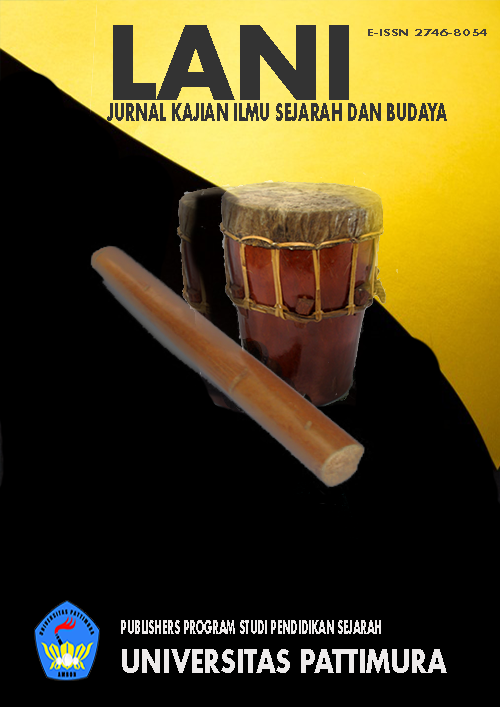Sejarah Dan Dinamika Budaya Etnis Tionghoa Di Pulau Geser Kecamatan Seram Timur Kabupaten Seram Bagian Timur
History and Cultural Dynamics of the Chinese Ethnic Group on Geser Island, East Seram District, East Seram Regency
Abstract
The history of the arrival of Chinese ethnic groups in Indonesia is generally uncertain, and this is also true for their arrival on Geser Island. Even if there are sources that document the arrival of the Chinese, they are mostly based on local folklore and some evidence left by Chinese descendants who still live there today, some of whom have intermarried with the indigenous people of Geser. The issues examined in this study are as follows: 1) What was the process of the Chinese community's arrival on Geser Island? 2) How have the dynamics between the Chinese community and the local population on Geser Island evolved? To address these questions, the research method used is historical research, which consists of four stages: Heuristics, Verification, Interpretation, and Historiography, while also employing relevant theories and concepts from social sciences. The objectives of this study are to explain the process of the Chinese community's arrival on Geser Island and their interactions with the local community. It can be observed from the involvement of the Chinese community in the practice of local customs and culture that they have integrated into their lives. To this day, the Chinese community plays a significant role in various sectors of life on Geser Island, both in the economic and political realms. It is evident from the term "Cina Geser" used to refer to some Chinese-descended politicians, including members of the East Seram Regency Regional House of Representatives and even the current Acting Secretary of the Maluku Provincial Government, who is of Chinese descent.
Downloads
References
Agustan dan Sopian Tamrin. (2012). Merantau: Studi Tentang Faktor Pendorong Dan Dampak Sosial Ekonomi Terhadap Aktivitas Merantau Di Desa Sijelling Kecamatan Tellu Siattinge Kabupaten Bone Oleh: Program Studi Sosiologi Fakultas Ilmu Sosial Universitas Negeri Makasar.
Eudoxia Binnendyk, dan Rina Pusparina. (2015). Dasar-Dasar Ilmu Sejarah. Ambon: Universitas Pattimura
Elly. M Setiadi. (2012). Ilmu Sosial Budaya Dasar. Jakarta: Kencana
Herimanto dan Winarno. (2009). IlmuSosial & Budaya Dasar. Jakarta: PT. Bumi Akasa
Johan Pattiasina. (2017). Etnis Tionghoa Dalam Dinamika Masyarakat Kepulauan Kei
Kaplan, D. (2002). Teori Budaya. Yogyakarta: Pustaka Pelajar.
Koentjaraningrat. (2019). Pengantar Ilmu Antropologi. Rineka Cipta: Jakarta
Koentjaraningrat. (2000). Kebudayaan Indonesia. Jakarta: Jambta.
Koentjaraningrat. (1981). Dasar-Dasar Antropologi. Jakarta: Rineka Cipta
Koengjaraninggrat. (1997). Manusia dan Kebudayaan di Indonesia. Bandung: PT Djambatan
Mulyadi. (1999). Psikologi Anak. Jakarta: Elex Media Kompetindo.
Nanang Martono. (2012). Sosiologi Perubahan Sosial, Prespektif Klasik, Modern, Posmodern, dan Poskolonial. Jakarta : Rajawali Pers
Supartono Widyosiswoyo. (2009). Ilmu Budaya Dasar. Bogor: Ghalia Indonesia
Tasmuji, Dkk. (2011). Ilmu Alamiah Dasar, Ilmu Sosial Dasar, Ilmu Budaya Dasar. Surabaya: IAIN Sunan Ampel Press
Tim Penyusun Kamus Besar Bahasa Indonesia. (1988). Kamus Besar Bahasa Indonesia. Jakarta: Balai Pustaka
Wirawan.I.B. (2012). Teori-Teori Sosial Dalam Tiga Paradigma. Jakarta: Penerbit Pranamedia Group.
Yerri Wirawan. (2013). Sejarah Etnik Tionghoa Makasar, Dari abad ke-7 Hingga ke-20. Jakarta: Penerbit PT. Granmedia Jakarta
Copyright (c) 2022 Syahid H Rumalean, Nur Aida Kubangun, Johan Pattiasina

This work is licensed under a Creative Commons Attribution-ShareAlike 4.0 International License.








